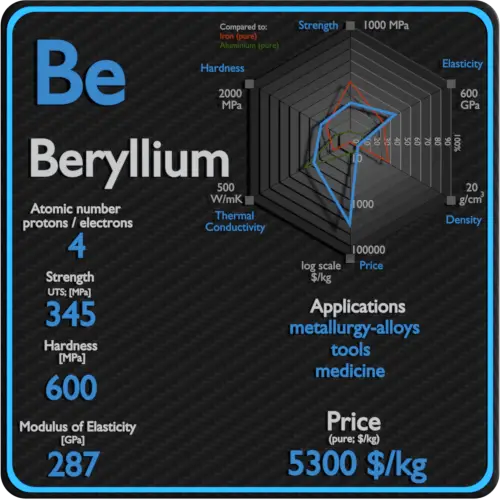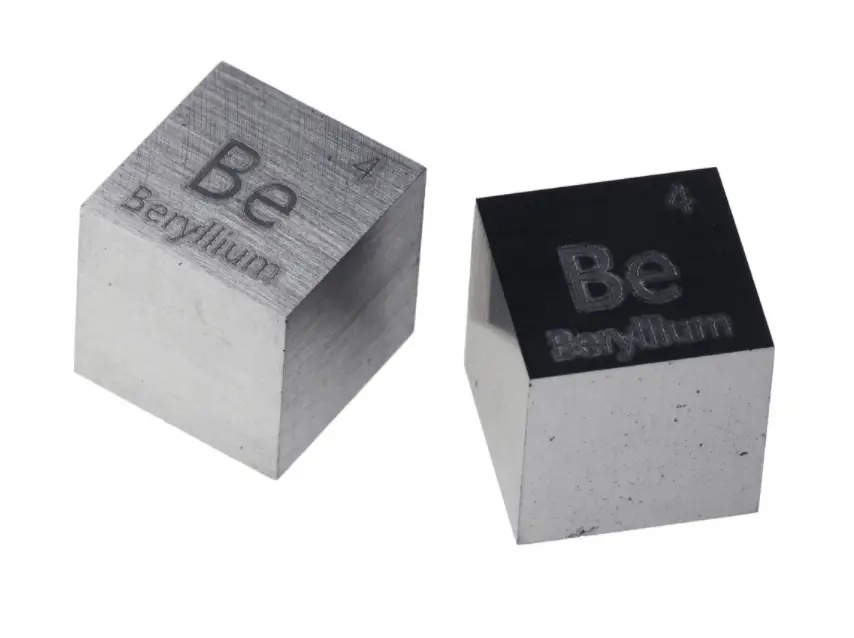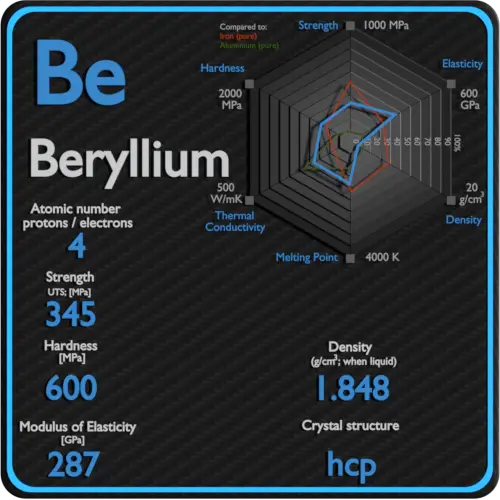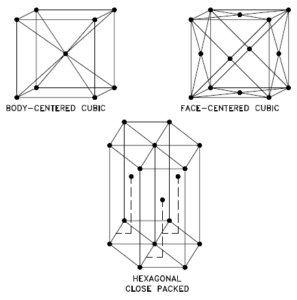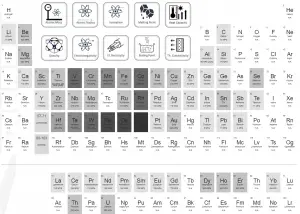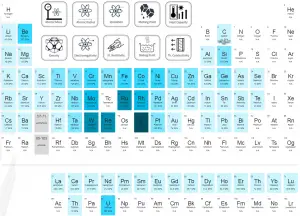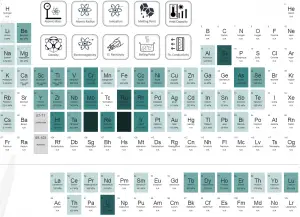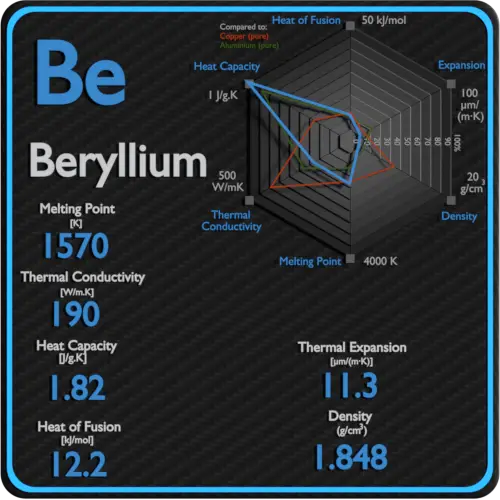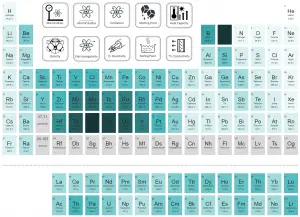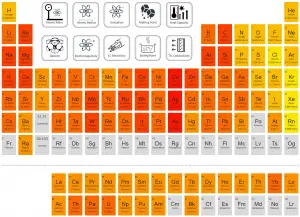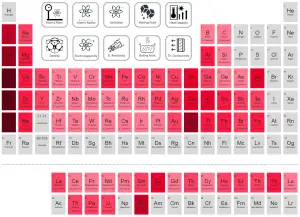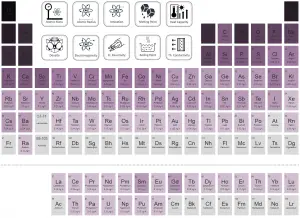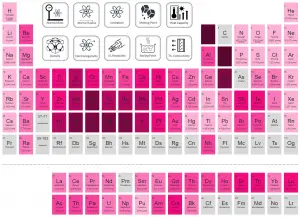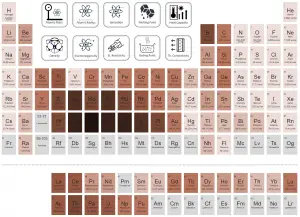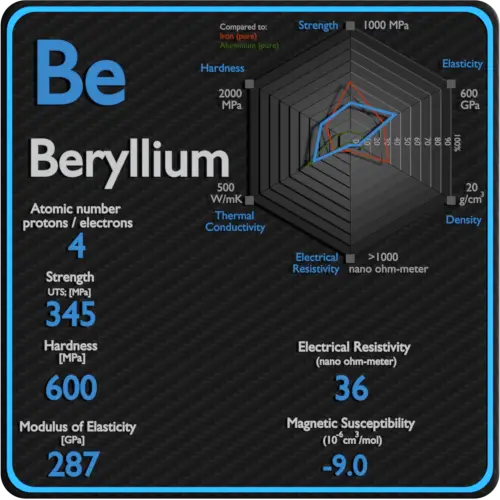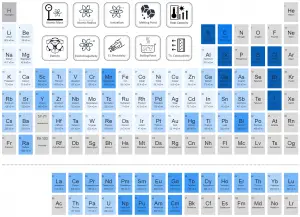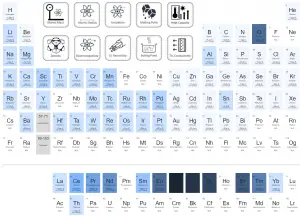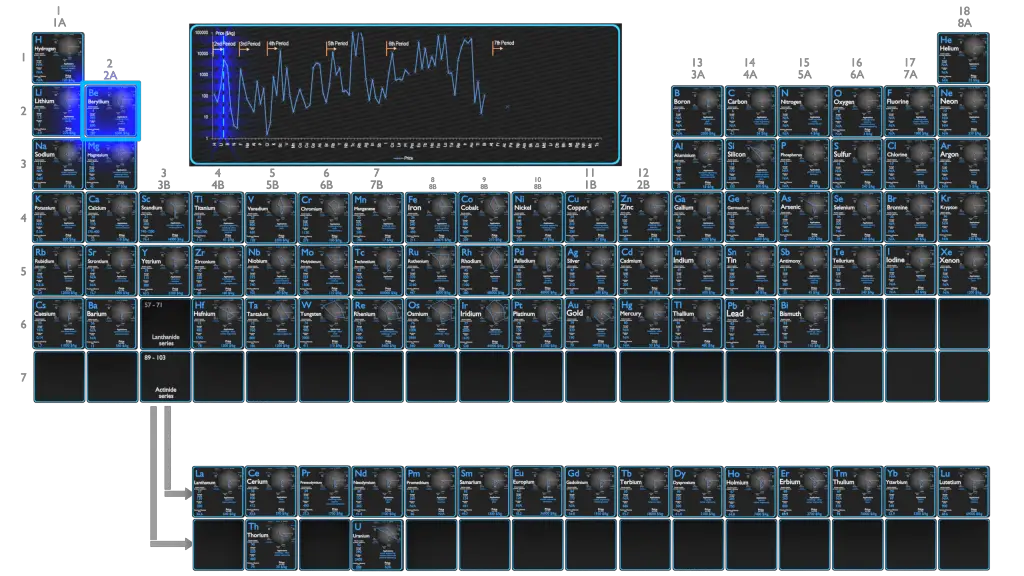About Beryllium
Beryllium is a hard, grayish metal naturally found in mineral rocks, coal, soil, and volcanic dust. The commercial use of beryllium requires the use of appropriate dust control equipment and industrial controls at all times because of the toxicity of inhaled beryllium-containing dusts that can cause a chronic life-threatening allergic disease in some people called berylliosis. Beryllium has a large scattering cross section for high-energy neutrons, about 6 barns for energies above approximately 10 keV. Therefore, it works as a neutron reflector and neutron moderator, effectively slowing the neutrons to the thermal energy. Since berylium has very low threshold energy for neutron emission, it can be used as a neutron source in nuclear reactors. The Sb-Be source is based on (γ,n) reaction (i.e. it emits photoneutrons).
Summary
| Element | Beryllium |
| Atomic number | 4 |
| Element category | Alkaline Earth Metal |
| Phase at STP | Solid |
| Density | 1.848 g/cm3 |
| Ultimate Tensile Strength | 345 MPa |
| Yield Strength | N/A |
| Young’s Modulus of Elasticity | 287 GPa |
| Mohs Scale | 5.5 |
| Brinell Hardness | 600 MPa |
| Vickers Hardness | 1670 MPa |
| Melting Point | 1278 °C |
| Boiling Point | 2469 °C |
| Thermal Conductivity | 200 W/mK |
| Thermal Expansion Coefficient | 11.3 µm/mK |
| Specific Heat | 1.82 J/g K |
| Heat of Fusion | 12.2 kJ/mol |
| Heat of Vaporization | 292.4 kJ/mol |
| Electrical resistivity [nanoOhm meter] | 36 |
| Magnetic Susceptibility | −9.0e-6 cm^3/mol |
Applications of Beryllium
Berylium can be utilized as alloying agent in production of beryllium-copper, X-ray detection diagnostics, manufacture of computer peripherals, in nuclear reactors as neutron moderators and reflectors. 80% of the beryllium used goes into copper beryllium alloys. The combination of light weight with high strength at extreme temperatures makes beryllium metal and aluminium beryllium alloys ideal for use in high performance aerospace applications such as components of rockets. Transparency to x-radiation makes pure beryllium metal essential in security equipment and high-resolution medical imaging technology, such as mammography to detect breast cancer. Copper beryllium is the hardest and strongest of any copper alloy (UTS up to 1,400 MPa), in the fully heat treated and cold worked condition. It combines high strength with non-magnetic and non-sparking qualities and it is similar in mechanical properties to many high strength alloy steels but, compared to steels, it has better corrosion resistance.
Production and Price of Beryllium
Raw materials prices change daily. They are primarily driven by supply, demand and energy prices. In 2019, prices of pure Beryllium were at around 5300 $/kg.
Beryllium content on earth’s crust is 2.6 ppm. It is one of the most toxic elements, hence causes damage to human lungs and other organisms. It is found in as many as 30 different minerals. Beryllium is most commonly extracted from the mineral beryl, which is either sintered using an extraction agent or melted into a soluble mixture. The sintering process involves mixing beryl with sodium fluorosilicate and soda at 770 °C (1,420 °F) to form sodium fluoroberyllate, aluminium oxide and silicon dioxide. Beryllium can also be readily recycled from scrap alloys. However, the quantity of recycled materials is variable and limited due to its use in dispersive technologies, such as electronics.
Source: www.luciteria.com
Mechanical Properties of Beryllium
Strength of Beryllium
In mechanics of materials, the strength of a material is its ability to withstand an applied load without failure or plastic deformation. Strength of materials basically considers the relationship between the external loads applied to a material and the resulting deformation or change in material dimensions. In designing structures and machines, it is important to consider these factors, in order that the material selected will have adequate strength to resist applied loads or forces and retain its original shape. Strength of a material is its ability to withstand this applied load without failure or plastic deformation.
For tensile stress, the capacity of a material or structure to withstand loads tending to elongate is known as ultimate tensile strength (UTS). Yield strength or yield stress is the material property defined as the stress at which a material begins to deform plastically whereas yield point is the point where nonlinear (elastic + plastic) deformation begins.
See also: Strength of Materials
Ultimate Tensile Strength of Beryllium
Ultimate tensile strength of Beryllium is 345 MPa.
Yield Strength of Beryllium
Yield strength of Beryllium is N/A.
Modulus of Elasticity of Beryllium
The Young’s modulus of elasticity of Beryllium is 287 GPa.
Hardness of Beryllium
In materials science, hardness is the ability to withstand surface indentation (localized plastic deformation) and scratching. Brinell hardness test is one of indentation hardness tests, that has been developed for hardness testing. In Brinell tests, a hard, spherical indenter is forced under a specific load into the surface of the metal to be tested.
Brinell hardness of Beryllium is approximately 600 MPa.
The Vickers hardness test method was developed by Robert L. Smith and George E. Sandland at Vickers Ltd as an alternative to the Brinell method to measure the hardness of materials. The Vickers hardness test method can be also used as a microhardness test method, which is mostly used for small parts, thin sections, or case depth work.
Vickers hardness of Beryllium is approximately 1670 MPa.
Scratch hardness is the measure of how resistant a sample is to permanent plastic deformation due to friction from a sharp object. The most common scale for this qualitative test is Mohs scale, which is used in mineralogy. The Mohs scale of mineral hardness is based on the ability of one natural sample of mineral to scratch another mineral visibly.
Beryllium is has a hardness of approximately 5.5.
See also: Hardness of Materials
Beryllium – Crystal Structure
A possible crystal structure of Beryllium is hexagonal close-packed structure.
In metals, and in many other solids, the atoms are arranged in regular arrays called crystals. A crystal lattice is a repeating pattern of mathematical points that extends throughout space. The forces of chemical bonding causes this repetition. It is this repeated pattern which control properties like strength, ductility, density, conductivity (property of conducting or transmitting heat, electricity, etc.), and shape. There are 14 general types of such patterns known as Bravais lattices.
See also: Crystal Structure of Materials
Crystal Structure of Beryllium
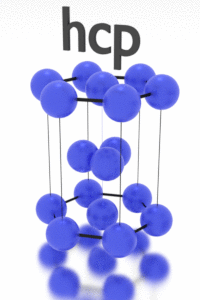
Thermal Properties of Beryllium
Beryllium – Melting Point and Boiling Point
Melting point of Beryllium is 1278°C.
Boiling point of Beryllium is 2469°C.
Note that, these points are associated with the standard atmospheric pressure.
Beryllium – Thermal Conductivity
Thermal conductivity of Beryllium is 200 W/(m·K).
The heat transfer characteristics of a solid material are measured by a property called the thermal conductivity, k (or λ), measured in W/m.K. It is a measure of a substance’s ability to transfer heat through a material by conduction. Note that Fourier’s law applies for all matter, regardless of its state (solid, liquid, or gas), therefore, it is also defined for liquids and gases.
Coefficient of Thermal Expansion of Beryllium
Linear thermal expansion coefficient of Beryllium is 11.3 µm/(m·K)
Thermal expansion is generally the tendency of matter to change its dimensions in response to a change in temperature. It is usually expressed as a fractional change in length or volume per unit temperature change.
Beryllium – Specific Heat, Latent Heat of Fusion, Latent Heat of Vaporization
Specific heat of Beryllium is 1.82 J/g K.
Heat capacity is an extensive property of matter, meaning it is proportional to the size of the system. Heat capacity C has the unit of energy per degree or energy per kelvin. When expressing the same phenomenon as an intensive property, the heat capacity is divided by the amount of substance, mass, or volume, thus the quantity is independent of the size or extent of the sample.
Latent Heat of Fusion of Beryllium is 12.2 kJ/mol.
Latent Heat of Vaporization of Beryllium is 292.4 kJ/mol.
Latent heat is the amount of heat added to or removed from a substance to produce a change in phase. This energy breaks down the intermolecular attractive forces, and also must provide the energy necessary to expand the gas (the pΔV work). When latent heat is added, no temperature change occurs. The enthalpy of vaporization is a function of the pressure at which that transformation takes place.
Beryllium – Electrical Resistivity – Magnetic Susceptibility
Electrical property refers to the response of a material to an applied electric field. One of the principal characteristics of materials is their ability (or lack of ability) to conduct electrical current. Indeed, materials are classified by this property, that is, they are divided into conductors, semiconductors, and nonconductors.
See also: Electrical Properties
Magnetic property refers to the response of a material to an applied magnetic field. The macroscopic magnetic properties of a material are a consequence of interactions between an external magnetic field and the magnetic dipole moments of the constituent atoms. Different materials react to the application of magnetic field differently.
See also: Magnetic Properties
Electrical Resistivity of Beryllium
Electrical resistivity of Beryllium is 36 nΩ⋅m.
Electrical conductivity and its converse, electrical resistivity, is a fundamental property of a material that quantifies how Beryllium conducts the flow of electric current. Electrical conductivity or specific conductance is the reciprocal of electrical resistivity.
Magnetic Susceptibility of Beryllium
Magnetic susceptibility of Beryllium is −9.0e-6 cm^3/mol.
In electromagnetism, magnetic susceptibility is the measure of the magnetization of a substance. Magnetic susceptibility is a dimensionless proportionality factor that indicates the degree of magnetization of Beryllium in response to an applied magnetic field.
